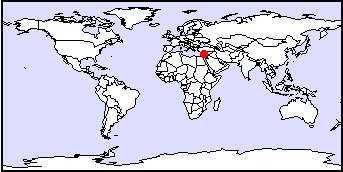Town/City:
|
Ruwaishid
|
State/Province:
|
Irbid
|
Country:
|
Jordan
|
Latitude/Longitude:
|
33.3N 34.0E
|
Information supplied by
Bruce Butwell
bruce_123@hotmail.com
1316 Scugog Ave. L1J 1J7 Oshawa, Ontario, Canada
(905)434-7016
Dated Sat Dec 19 11:00:56 1998 |
Information Topics:
City Description:
Ruwaishid is located in the northeastern part of Jordan, approximately
100 km north east of the capital of Amman. Rudwaishid falls within the
province of Irbid in the Azraq area, site of the Azraq oasis. The Azraq
oasis is the only permanent source of fresh water in the surrounding 30
thousand km2 of desert and, consequently, is in high demand. It also attracts
a large number of birds en route for migratory destinations. The pumping
of water from the oasis to supply an ever-increasing demand in Amman has
put a large strain on the aquifer. Part of the area is now protected as
a wetland reserve. Ruwaishid is a small town and is not a major commercial
centre in Jordan.
Back to Topics
Climate:
The climate of this area is arid to semi-arid with an annual rainfall ranging
from 60 mm to 150 mm a year. Rainfall occurs exclusively in the winter
months (November to March) and the mean winter daytime temperature is 17°
C with a minimum night time temperature of 5° C. The average relative
humidity during the winter months is 54%. In the summer (June to September)
rainfall is non-existent, the mean maximum daytime temperature is about
35° C (95° F) and the minimum night time temperature is 19°
C. Relative humidity during the summer is 31%. The average potential evaporation
rates based on pan measurements are between 1500 to 2000 mm/a.
Back to Topics
Basic Hydrogeology:
Underlying Ruwaishid and the surrounding Azraq area is a system of shallow
aquifers. The most recent and shallowest aquifer comprises an alluvial
sand and gravel of thickness 0-20 m. This is underlain by basalts of the
Quaternary/ late Tertiary period with a thickness of 0-400 m which supercedes
the Um Qirma (B5) formation, a weathered late Eocene limestone with a thickness
of 0-15 m. The next formation is the Wadi el Shailala (B5), it is 160-430
m thick and a major aquiclude that confines the Um Rijam (B4), the area
major aquifer. This highly transmissive argillaceous silicified limestone
deposits. The Muwaqar (B3) formation is a marly that acts as the base for
the active flow system. A variety of water budget approaches have indicated
that recharge of the groundwater in the basin varies between 1.45-3.27
mm/yr.
Back to Topics
Water Use:
The Azraq oasis is the only source of freshwater within 12 thousand square
miles and is therefore under considerable strain. The aquifer supplies
almost 100% of the potable water for the surrounding towns. The water from
the aquifer system is used for residential use, small agricultural uses
(only 570 km2 of irrigated land in Jordan) and also some industrial uses.
Back to Topics
Groundwater Issues:
Important issues include the exploitation of the Azraq area resulting in
a lowering water table and deteriorating water quality. Subsidence due
to over pumping is also an important issue in this area as well as low
recharge values.
Back to Topics
Groundwater Problems:
The waters of the Azraq basin and the Azraq oasis located adjacent to the
town of Ruwaishid in northern Jordan have been overexploited for more than
20 years resulting in a drop of the water table as well as degraded water
quality.This has been attributed to the migration of water from the deeper
Um Rijam aquifer, which is of lower quality and under artesian pressure.
This has resulted in the degradation and depletion of the oasis and the
ecosystem, which it supported. Although up to 300 bird species were recorded
visitors to the Azraq oasis during the 1970s, this number has declined
drastically.
Back to Topics
Solutions:
In order to protect the oasis some areas have been declared as a wetland
reserve and protected under environmental conservation laws. Another solution
to the diminishing water supplies is the introduction of water conservation
practices in areas that draw on water from the Azraq aquifer system. These
practices can include agricultural practices such as, drip irrigation in
order to lessen evaporative losses in this arid climate. Over watering
under high evaporation rates can lead to increased salinization of Jordan's
small amount of arable land.
Back to Topics
References and Other Author(s):
Abu-Jaber, N.S. et al, 1996, Use of solute and isotopic composition
of ground water to constrain in the ground water flow system of the Azraq
Area, Jordan. Groundwater 36, no.2: 361-365.
Al-Hommond, A. et al, 1996, A study on geology, geomorphology,
hydrology, groundwater, and physical resources of the desertified Badia
environment of Jordan. Towards sustainable development. Environmental Geology.
3:198-209.
Back to Topics
Contacts:
Back to Topics



